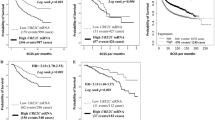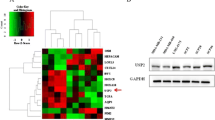Abstract
Purpose
Ubiquitin-specific protease 22 (USP22), a novel deubiquitinating enzyme, has been associated with metastasis, therapy resistance, and cell-cycle progression. The purpose of this study was to investigate the expression level of USP22 in breast samples and to evaluate its clinical significance in breast cancer patients.
Methods
Immunohistochemistry was used to determine the expression of USP22 protein in 31 breast fibroadenoma and 100 breast cancer patients in comparison with 34 normal breast specimens. Furthermore, we analyzed the correlation between the expression of the USP22 protein and various clinicopathologic factors including survival status of patients with breast cancer.
Results
The immunohistochemistry results showed that the expression level of USP22 protein in breast cancer samples was significantly higher than that in breast fibroadenoma and normal breast tissues (P = 0.003 and P = 0.021). Moreover, statistical analysis showed that high USP22 expression was positively related to lymph node metastasis, Her-2, Ki67, and recurrence. Furthermore, it was shown that patients with high USP22 expression had significantly poorer outcome compared with patients with low expression of USP22 for patients with positive lymph nodes. Multivariate Cox regression analysis revealed that USP22 expression level was an independent prognostic factor for both overall survival and disease-free survival (P = 0.039 and P = 0.041, respectively).
Conclusion
Overexpression of USP22 may contribute to the progression of breast cancer and thus may serve as a new molecular marker to predict the prognosis of breast cancer patients.




Similar content being viewed by others
References
Amerik AY, Hochstrasser M (2004) Mechanism and function of deubiquitinating enzymes. Biochim Biophys Acta 1695(1–3):189–207
Berger SL (2007) The complex language of chromatin regulation during transcription. Nature 447(7143):407–412
Bolden JE, Peart MJ, Johnstone RW (2006) Anticancer activities of histone deacetylase inhibitors. Nat Rev Drug Discov 5(9):769–784
Bouchard C, Dittrich O, Kiermaier A, Dohmann K, Menkel A, Eilers M et al (2001) Regulation of cyclin D2 gene expression by the Myc/Max/Mad network: Myc-dependent TRRAP recruitment and histone acetylation at the cyclin D2 promoter. Genes Dev 15(16):2042–2047
Choi HK, Choi BC, Lee SH, Kim JW, Cha KY, Baek KH (2003) Expression of angiogenesis- and apoptosis-related genes in chorionic villi derived from recurrent pregnancy loss patients. Mol Reprod Dev 66(1):24–31
Dang CV, O’Donnell KA, Zeller KI, Nguyen T, Osthus RC, Li F (2006) The c-Myc target gene network. Semin Cancer Biol 16(4):253–264
Feinberg AP, Tycko B (2004) The history of cancer epigenetics. Nat Rev Cancer 4(2):143–153
Frank SR, Schroeder M, Fernandez P, Taubert S, Amati B (2001) Binding of c-Myc to chromatin mediates mitogen-induced acetylation of histone H4 and gene activation. Genes Dev 15(16):2069–2082
Giannattasio M, Lazzaro F, Plevani P, Muzi-Falconi M (2005) The DNA damage checkpoint response requires histone H2B ubiquitination by Rad6-Bre1 and H3 methylation by Dot1. J Biol Chem 280(11):9879–9886
Glinsky GV (2005) Death-from-cancer signatures and stem cell contribution to metastatic cancer. Cell Cycle 4(9):1171–1175
Glinsky GV (2006) Genomic models of metastatic cancer: functional analysis of death-from-cancer signature genes reveals aneuploid, anoikis-resistant, metastasis-enabling phenotype with altered cell cycle control and activated Polycomb Group (PcG) protein chromatin silencing pathway. Cell Cycle 5(11):1208–1216
Glinsky GV, Berezovska O, Glinskii AB (2005) Microarray analysis identifies a death-from-cancer signature predicting therapy failure in patients with multiple types of cancer. J Clin Invest 115(6):1503–1521
Guney I, Wu S, Sedivy JM (2006) Reduced c-Myc signaling triggers telomere-independent senescence by regulating Bmi-1 and p16(INK4a). Proc Natl Acad Sci USA 103(10):3645–3650
Ingvarsdottir K, Krogan NJ, Emre NC, Wyce A, Thompson NJ, Emili A et al (2005) H2B ubiquitin protease Ubp8 and Sgf11 constitute a discrete functional module within the Saccharomyces cerevisiae SAGA complex. Mol Cell Biol 25(3):1162–1172
Jemal A, Bray F, Center MM, Ferlay J, Ward E, Forman D (2011) Global cancer statistics. CA Cancer J Clin 61(2):134
Jones PA, Baylin SB (2007) The epigenomics of cancer. Cell 128(4):683–692
Lee HJ, Kim MS, Shin JM, Park TJ, Chung HM, Baek KH (2006) The expression patterns of deubiquitinating enzymes, USP22 and Usp22. Gene Expr Patterns 6(3):277–284
Liu YL, Yang YM, Xu H, Dong XS (2011) Aberrant expression of USP22 is associated with liver metastasis and poor prognosis of colorectal cancer. J Surg Oncol 103(3):283–289
Lv L, Xiao XY, Gu ZH, Zeng FQ, Huang LQ, Jiang GS (2011) Silencing USP22 by asymmetric structure of interfering RNA inhibits proliferation and induces cell cycle arrest in bladder cancer cells. Mol Cell Biochem 346(1–2):11–21
Rakha EA, El-Sayed ME, Green AR, Lee AH, Robertson JF, Ellis IO (2007) Prognostic markers in triple-negative breast cancer. Cancer 109(1):25–32
Ross JS, Fletcher JA, Linette GP, Stec J, Clark E, Ayers M et al (2003) The Her-2/neu gene and protein in breast cancer 2003: biomarker and target of therapy. Oncologist 8(4):307–325
Stephen JK, Vaught LE, Chen KM, Sethi S, Shah V, Benninger MS et al (2007) Epigenetic events underlie the pathogenesis of sinonasal papillomas. Mod Pathol 20(10):1019–1027
Su P, Zhang Q, Yang Q (2010) Immunohistochemical analysis of Metadherin in proliferative and cancerous breast tissue. Diagn Pathol 5:38
Weigelt B, Wessels LF, Bosma AJ, Glas AM, Nuyten DS, He YD et al (2005) No common denominator for breast cancer lymph node metastasis. Br J Cancer 93(8):924–932
Wyce A, Xiao T, Whelan KA, Kosman C, Walter W, Eick D et al (2007) H2B ubiquitylation acts as a barrier to Ctk1 nucleosomal recruitment prior to removal by Ubp8 within a SAGA-related complex. Mol Cell 27(2):275–288
Zhang X, Kolaczkowska A, Devaux F, Panwar SL, Hallstrom TC, Jacq C et al (2005) Transcriptional regulation by Lge1p requires a function independent of its role in histone H2B ubiquitination. J Biol Chem 280(4):2759–2770
Zhang XY, Pfeiffer HK, Thorne AW, McMahon SB (2008a) USP22, an hSAGA subunit and potential cancer stem cell marker, reverses the polycomb-catalyzed ubiquitylation of histone H2A. Cell Cycle 7(11):1522–1524
Zhang XY, Varthi M, Sykes SM, Phillips C, Warzecha C, Zhu W et al (2008b) The putative cancer stem cell marker USP22 is a subunit of the human SAGA complex required for activated transcription and cell-cycle progression. Mol Cell 29(1):102–111
Zhao Y, Lang G, Ito S, Bonnet J, Metzger E, Sawatsubashi S et al (2008) A TFTC/STAGA module mediates histone H2A and H2B deubiquitination, coactivates nuclear receptors, and counteracts heterochromatin silencing. Mol Cell 29(1):92–101
Acknowledgments
The authors thank Dr Yanlong Liu, Department of Colorectal Surgery, and Dr. Hongtao Song, Department of Pathology, the Third Affiliated Hospital for excellent technical assistance with the immunohistochemical studies and PhD. Tao Zhang, Department of Biostatistics, Harbin Medical University for the statistical analysis.
Conflicts of interest
No potential conflicts of interest were disclosed.
Author information
Authors and Affiliations
Corresponding author
Additional information
Youxue Zhang and Lei Yao were equally contributed.
Rights and permissions
About this article
Cite this article
Zhang, Y., Yao, L., Zhang, X. et al. Elevated expression of USP22 in correlation with poor prognosis in patients with invasive breast cancer. J Cancer Res Clin Oncol 137, 1245–1253 (2011). https://doi.org/10.1007/s00432-011-0998-9
Received:
Accepted:
Published:
Issue Date:
DOI: https://doi.org/10.1007/s00432-011-0998-9




